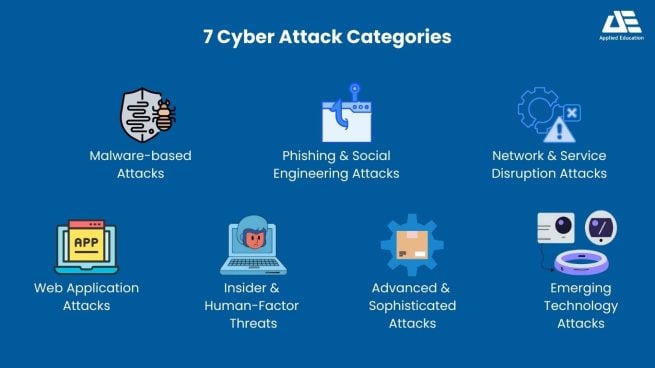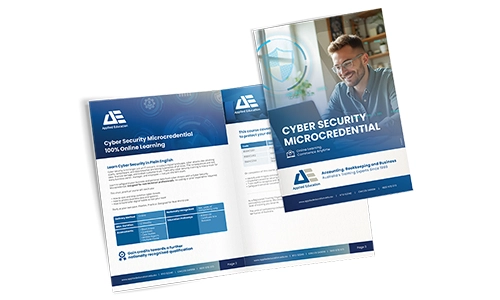
Published: July 2025
Cyber attacks happen when someone deliberately tries to access, damage, or steal information from computer systems, networks, or devices without permission. And the truth is, no one’s off-limits — from everyday internet users to big companies, anyone can be a target.
The good news? Knowing what kinds of attacks are out there makes you much harder to fool. In this guide, we’ll walk through 7 major categories of cyber attacks, break down how they work, and share simple, practical ways to protect yourself and your business.
If you’re completely new to the topic and want a clearer picture of what cyber security actually means, check out our guide on cyber security before diving in. It’s a simple breakdown to help you connect the dots.
Table of Contents
Cyber Attack Categories and Their Different Types
Believe it or not, cyber attacks are constantly evolving, and businesses face risks every day. From simple scams to advanced, targeted campaigns, attackers use different methods to steal information, disrupt systems, or gain control. Below are the major types of cyber attacks, explained with examples and prevention tips.

Phishing & Social Engineering Attacks
These attacks trick people into revealing sensitive information rather than hacking systems directly.
- Phishing – deceptive emails or websites that steal login credentials or banking details.
- Spear Phishing – a highly personalised type of attack that targets specific employees or companies to reveal sensitive data.
- Whale Phishing (Whaling) – a highly targeted form of spear phishing where cyber criminals pretend to be a trusted member of a company to gain high-level access or gain sensitive company data.
- Smishing – phishing delivered via SMS.
- Vishing – conducted through voice calls or voicemails.
- Pretexting – pretexting is when an attacker invents a false story or impersonates someone trustworthy to trick a victim into sharing sensitive information or taking an action that puts security at risk.
- Baiting – Baiting is a cyber attack where attackers lure victims with something tempting—like free software, gift cards, or downloads—to trick them into downloading malware or giving up login details.
- Tailgating – Tailgating, or piggybacking, is when an unauthorized person gains physical access to a restricted area by following someone with permission—often by exploiting politeness, like holding a door open. It’s a common social engineering tactic to bypass security.
How do you stop it?
Install corporate-grade antivirus like Bitdefender or deploy Microsoft Defender tools.
Malware-Based Attacks
Malware is malicious software designed to damage, disrupt, or steal data. An example of malware is an employee clicking a link that installs a malicious application. Did you know that even some Chrome browser extensions can contain malware!
- Viruses, Worms, Trojans, Spyware – malicious programs that spread, spy, or damage systems.
- Ransomware – locks or encrypts a victim’s data and demands payment to restore access. High-profile cases, like the WannaCry outbreak in 2017, targeted computers running Microsoft Windows, which affected over 150 countries.
- Drive-by Downloads – malware installed without consent, often just by visiting a compromised website.
How do you stop it?
Add “permission” controls to your Windows users, ie., set your staff up as “standard” users, not admin users when they log in to Windows.

Network & Service Disruption Attacks
These attacks flood, hijack, or redirect traffic to make systems unavailable or unsafe.
- Denial of Service (DoS) & Distributed Denial of Service (DDoS) – overwhelm servers with traffic, shutting down websites or apps.
- Man-in-the-Middle (MitM) Attacks – intercept communication between two parties (e.g., on unsecured Wi-Fi) to steal logins or financial data.
- Session Hijacking – stealing or manipulating session tokens to impersonate users.
- DNS Spoofing (DNS Cache Poisoning) – redirects traffic from legitimate websites to fake ones.
How do you stop it?
The best defense here is a mix of safe browsing habits and strong network security. Stick to secure connections (look for HTTPS and use a VPN on public Wi-Fi), log out of apps when you’re done, and don’t ignore those browser security warnings. For businesses, investing in DDoS protection and monitoring tools can make a huge difference in keeping systems online and safe.
Web Application Attacks
Hackers exploit weaknesses in web applications to steal or manipulate data.
- SQL Injection – inserts malicious queries into websites, exposing or altering database info.
- Cross-Site Scripting (XSS) – injects harmful scripts into trusted websites, stealing cookies or hijacking sessions.
- Password Attacks – brute force, dictionary attacks, and credential stuffing to break into accounts.
- Credential Stuffing – reusing stolen username-password combos from one breach to access other accounts.
How do you stop it?
A lot of these attacks work because apps or accounts aren’t set up with enough safeguards. Using strong, unique passwords (and a password manager if you need help) goes a long way. For developers, the key is testing apps for vulnerabilities and plugging holes before hackers find them. And for everyday users? Turning on multi-factor authentication (MFA) is one of the easiest wins for keeping accounts safe.
Insider & Human-Factor Threats
Not all cyber threats come from outside — employees or contractors can cause breaches.
- Insider Threats – intentional or accidental misuse of access rights.
How do you stop it?
Keep access on a “need-to-know” basis, watch for unusual account activity, and give staff regular (and easy-to-follow) training so they know how to avoid slip-ups.

Advanced & Sophisticated Attacks
These are stealthy, targeted, and often state-sponsored.
- Advanced Persistent Threats (APTs) – long-term intrusions that steal sensitive data over months or years.
- Zero-Day Exploits – attacks on software flaws before a patch is available.
Prevention: Rapid patching, intrusion detection, and threat intelligence monitoring. - Supply Chain Attacks – targeting vendors or software suppliers to compromise many organisations at once (e.g., SolarWinds).
- AI-Powered & Deepfake Attacks – AI-generated phishing, fake voices, and videos to trick employees.
How do you stop it?
Build a culture of “trust but verify.” If a request feels off — even if it looks or sounds real — double-check through another channel before acting.
Emerging Technology Attacks
As businesses adopt new tech, attackers follow.
- IoT-Based Attacks – exploiting vulnerable smart devices like cameras, thermostats, or wearables to gain access.
- Cloud Attacks – exploiting misconfigured settings or weak identity controls in cloud services.
How do you stop it?
Encrypt the data you store, set strict access rules, and run regular audits to make sure nothing is left wide open.
Best Practice to Stay Protected
No single tool can guarantee safety online, but combining smart habits with the right knowledge can make you a much harder target. Here are a few simple practices you can put in place right away:
- Use strong, unique passwords and consider a password manager to keep track.
- Turn on multi-factor authentication (MFA) — it’s one of the easiest ways to block hackers.
- Keep your software updated so new vulnerabilities don’t become open doors.
- Back up your data regularly to avoid losing everything in a ransomware attack.
- Think twice before clicking links or attachments — phishing is still the number one way attackers break in.
But good habits only go so far — real protection comes from understanding how cyber attacks work and how to stop them. That’s where training makes the difference.
At Applied Education, we make learning cyber security accessible:
- Eligible WA residents can enrol in a 100% fee-free cyber security course (AE781 Cyber Security Skill Set).
- We also have a flexible, 100% online course, designed to fit around work and life.
With the right skills, you’ll not only protect yourself but also gain valuable knowledge on how to get into an in-demand industry.

Learn Cyber Security Essentials with Applied Education
Protecting yourself and your business from online threats starts with the right knowledge. Applied Education’s Cyber Security Essentials course gives you practical skills to identify risks, defend against common attacks, and build safer digital habits.
Whether you’re a beginner or looking to strengthen your workplace security, this course is designed to make cyber safety simple and relevant. Learn how to spot scams, secure your data, and confidently handle the latest digital threats — all with step-by-step guidance.
Stay one step ahead of hackers. Start learning cyber security essentials with Applied Education today.


